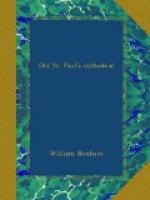“Hic jacet Ethelredus Anglorum Rex, filius Edgari Regis; cui in die consecrationis his, post impositam Coronam, fertur S. Dunstanus Archiepiscopus dira praedixisse his verbis: Quoniam aspirasti ad regnum per mortem fratris tui, in cujus sanguinem conspiraverunt Angli, cum ignominiosa matre tua; non deficiet gladius de domo tua, saeviens in te omnibus diebus vitae tuae; interficiens de semine tuo quousque Regnum tuum transferatur in Regnum alienum, cujus ritum et linguam Gens cui praesides non novit; nec expiabitur nisi longa vindicta peccatum tuum, & peccatum matris tuae, & peccatum virorum qui interfuere consilio illius nequam: Quae sicut a viro sancto praedicta evenerunt; nam Ethelredus variis praeliis per Suanum Danorum Regem filiumque suum Canutum fatigatus et fugatus, ac tandem Londoni arcta obsidione conclusus, misere diem obiit Anno Dominicae Incarnationis MXVII. postquam annis XXXVI. in magna tribulatione regnasset."[2]
Certainly in this latter terrible epitaph, it cannot be said that the maxim de mortuis was observed. But it speaks the truth.
Of a much later date is a royal monument, not indeed of a king, but of the son and father of kings, namely, John of Gaunt. He died in 1399, and his tomb in St. Paul’s was as magnificent as those of his father in the Confessor’s Chapel at Westminster, and of his son at Canterbury. It was indeed a Chantry founded by Henry IV. to the memory of his father and mother, Gaunt and Blanche of Lancaster. She was Gaunt’s first wife (d. 1369), and bore him not only Henry IV., but Philippa, who became wife of the King of Portugal, and Elizabeth, wife of John Holland, Earl of Huntingdon. It was through Blanche that Gaunt got his dukedom of Lancaster. She died of plague in 1369, during his absence in the French Wars, and was buried here. Before his return to England he had married (in 1371) Constance, daughter of Pedro the Cruel, and hereby laid claim to the crown of Castile, as the inscription on his monument recorded. Their daughter married Henry, Prince of the Asturias, afterwards King of Castile. Constance died in 1394, and was also buried in St. Paul’s, though her effigy was not on the tomb. In January, 1396, he married Catharine Swynford, who had already borne him children, afterwards legitimised. One of them was the great Cardinal Beaufort; another, John Beaufort, Earl of Somerset, was the grandfather of Margaret Tudor, mother of Henry VII. Gaunt’s third wife (d. 1403) is buried at Lincoln. The long inscription on the monument closed with the words, “Illustrissimus hic princeps Johannes cognomento Plantagenet, Rex Castilliae et Legionis, Dux Lancastriae, Comes Richmondiae, Leicestriae, Lincolniae et Derbiae, locum tenens Aquitaniae, magnus Seneschallus Angliae, obiit anno XXII. regni regis Ricardi secundi, annoque Domini MCCCXCIX.”




